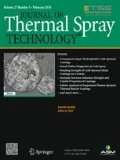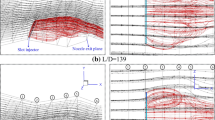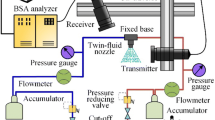Abstract
The computational fluid dynamics approach is adopted in this work using the design of experiments to reveal the effect of the air-cap configurations on the obtained gas velocity, the shear stresses, the high velocity zone, and the convergence of the obtained spraying plume in the twin-wire arc-spraying process. The parameters, which are revealed to optimize the air-cap configuration, are the throat diameter, the convergence angle of the throat inlet, the throat length, and the distance between the throat outlet and the intersection point of the approaching wires. The throat length is dependent upon the other configuration parameters. Outlet gas velocity, the turbulence in the flow, and the exerted shear stresses at wire tips are directly affected by the dominating flow regimes near the intersection point of the approaching wires. The presence of wires and the contact tips in the gas flow has enormous impact on the obtained flow characteristics. Air-cap throat diameter and the distance between throat outlet and intersection point determine the shape and length of the obtained high velocity zone in the spraying plum.











Similar content being viewed by others
References
D. Sacriste, N. Goubot, J. Dhers, M. Ducos, and A. Vardelle, An Evaluation of the Electric Arc Spray and (HPPS) Processes for the Manufacturing of High Power Plasma Spraying MCrAlY Coatings, J. Therm. Spray Technol., 2001, 352, p 352-358
H.L. Liao, Y.L. Zhu, R. Bolot, C. Coddet, and S.N. Ma, Size Distribution of Particles from Individual Wires and the Effects of Nozzle Geometry in Twin Wire Arc Spraying, Surf. Coat. Technol., 2005, 200, p 2123-2130
T. Watanabe, T. Sato, and A. Nezu, Electrode Phenomena Investigation of Wire Arc Spraying for Preparation of Ti-Al Inter-Metallic Compounds, Thin Solid Films, 2002, 407, p 98-103
D.J. Varacalle, D.P. Zeek, V. Zanchuck, E. Sampson, K.W. Couch, D. Benson, and G.S. Cox, Experimental Studies of Twin-Wire Electric Arc Sprayed Zinc/Aluminum Alloy Coatings, J. Therm. Spray Technol., 1998, 4, p 513-520
H.L. Liao, Y.L. Zhu, R. Bolot, C. Coddet, and S.N. Ma, Size Distribution of Particles from Individual Wires and the Effects of Nozzle Geometry in Twin Wire Arc Spraying, Surf. Coat. Technol., 2005, 200, p 2123-2130
S.P. Mates and G.S. Settles, A Study of Liquid Metal Atomization Using Close-Coupled Nozzles, Part 1: Gas Dynamic Behavior, Atom. Sprays, 2005, 15(1), p 19-40
S.P. Mates and G.S. Settles, A Study of Liquid Metal Atomization Using Close-Coupled Nozzles, Part 2: Atomization Behavior, Atom. Sprays, 2005, 15(1), p 41-60
R. Bolot, R. Bonnet, G. Jandin, and C. Coddet, Application of CAD to CFD for the Wire Arc Spray Process. Thermal Spray, ASM International, Materials Park, OH, 2001, p 889-894
M. Kelkar and J. Heberlein, Wire-Arc Spray Modeling, Plasma Chem. Plasma Process., 2002, 22(1), p 1-25
R. Bolot, H. Liao, C. Mateus, C. Coddet, and J.-M. Bordes, Optimization of a Rotating Twin Wire Arc Spray Gun, J. Therm. Spray Technol., 2007, 16(5-6), p 783-790
W. Tillmann, E. Vogli, M. Abdulgader, M. Gurri, D. Kuzmin, and S. Turek, Particle Behavior During the Arc Spraying Process with Cored Wires, J. Therm. Spray Technol., 2008, 17(5-6), p 966-973
Y. Chen, X. Liang, Y. Liu, and B. Xu, Numerical Analysis of the Effect of Arc Spray Gun Configuration Parameters on the External Gas Flow, J. Mater. Process. Technol., 2009, 209(18-19), p 5924-5931
Y. Chen, X. Liang, S. Wei, X. Chen, and B. Xu, Numerical Simulation of the Twin-Wire Arc Spraying Process: Modeling the High Velocity Gas Flow Field Distribution and Droplets Transport, J. Therm. Spray Technol., 2011, 21(2), p 263-274
S.L. Toma, C. Bejinariu, R. Baciu, and S. Radu, The Effect of Frontal Nozzle Geometry and Gas Pressure on the Steel Coating Properties Obtained by Wire Arc Spraying, Surf. Coat. Technol., 2013, 220, p 266-270
Solidworks Flow Simulation Guide, 2012
W. Tillmann, M. Abdulgader, H.G. Rademacher, and N. Anjami, Adapting of the Background-Oriented Schlieren (BOS) Technique in the Characterization of the Flow Regimes in Thermal Spraying Processes, J. Therm. Spray Technol., 2014, 23(1-2), p 21-30
Acknowledgments
The authors gratefully acknowledge the financial support of the DFG (Deutsche Forschungsgemeinschaft) within the collaborative research Centre SFB708/TP-B3-A1.
Author information
Authors and Affiliations
Corresponding author
Additional information
This article is an invited paper selected from presentations at the 2014 International Thermal Spray Conference, held May 21-23, 2014, in Barcelona, Spain, and has been expanded from the original presentation.
Rights and permissions
About this article
Cite this article
Tillmann, W., Abdulgader, M., Anjami, N. et al. Studying the Effect of the Air-Cap Configuration in Twin-Wire Arc-Spraying Process on the Obtained Flow Characteristics Using Design of Experiment Oriented Fluid Simulation. J Therm Spray Tech 24, 46–54 (2015). https://doi.org/10.1007/s11666-014-0183-1
Received:
Revised:
Published:
Issue Date:
DOI: https://doi.org/10.1007/s11666-014-0183-1




